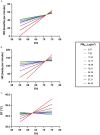Effects of wildfire smoke PM2.5 on indicators of inflammation, health, and metabolism of preweaned Holstein heifers
- PMID: 37465977
- PMCID: PMC10449420
- DOI: 10.1093/jas/skad246
Effects of wildfire smoke PM2.5 on indicators of inflammation, health, and metabolism of preweaned Holstein heifers
Abstract
Wildfires are a growing concern as large, catastrophic fires are becoming more commonplace. Wildfire smoke consists of fine particulate matter (PM2.5), which can cause immune responses and disease in humans. However, the present knowledge of the effects of wildfire PM2.5 on dairy cattle is sparse. The present study aimed to elucidate the effects of wildfire-PM2.5 exposure on dairy calf health and performance. Preweaned Holstein heifers (N = 15) were assessed from birth through weaning, coinciding with the 2021 wildfire season. Respiratory rate, heart rate, rectal temperatures, and health scores were recorded and blood samples were collected weekly or twice a week for analysis of hematology, blood metabolites, and acute phase proteins. Hourly PM2.5 concentrations and meteorological data were obtained, and temperature-humidity index (THI) was calculated. Contribution of wildfires to PM2.5 fluxes were determined utilizing AirNowTech Navigator and HYSPLIT modeling. Mixed models were used for data analysis, with separate models for lags of up to 7 d, and fixed effects of daily average PM2.5, THI, and PM2.5 × THI, and calf as a random effect. THI ranged from 48 to 73, while PM2.5 reached concentrations up to 118.8 µg/m3 during active wildfires. PM2.5 and THI positively interacted to elevate respiratory rate, heart rate, rectal temperature, and eosinophils on lag day 0 (day of exposure; all P < 0.05). There was a negative interactive effect of PM2.5 and THI on lymphocytes after a 2-d lag (P = 0.03), and total white blood cells, neutrophils, hemoglobin, and hematocrit after a 3-d lag (all P < 0.02), whereas there was a positive interactive effect on cough scores and eye scores on lag day 3 (all P < 0.02). Glucose and NEFA were increased as a result of combined elevated PM2.5 and THI on lag day 1, whereas BHB was decreased (all P < 0.05). Contrarily, on lag day 3 and 6, there was a negative interactive effect of PM2.5 and THI on glucose and NEFA, but a positive interactive effect on BHB (all P < 0.03). Serum amyloid A was decreased whereas haptoglobin was increased with elevated PM2.5 and THI together on lag days 0 to 4 (all P < 0.05). These findings indicate that exposure to wildfire-derived PM2.5, along with increased THI during the summer months, elicits negative effects on preweaned calf health and performance both during and following exposure.
Keywords: acute phase response; air quality; dairy calf; hematology; inflammation.
Plain language summary
Wildfires contribute to fine particulate matter (PM2.5) pollution throughout the United States. Wildfire-PM2.5 exposure negatively affects human health and dairy cow production; however, the effects on calves are not known. We monitored preweaned calves exposed to natural wildfires to understand how wildfire-PM2.5 exposure affects calf health and performance. Calves exposed to wildfire PM2.5 and elevated temperature–humidity index (THI) experienced respiratory symptoms, alterations in blood cell composition and metabolism, and changes in circulating inflammatory proteins. These results suggest that PM2.5 along with increased THI induced an inflammatory response and alterations in energy metabolism that may contribute to calf health and performance deficits.
© The Author(s) 2023. Published by Oxford University Press on behalf of the American Society of Animal Science. All rights reserved. For permissions, please e-mail: journals.permissions@oup.com.
Conflict of interest statement
The authors declare no real or perceived conflicts of interest.
Figures




Similar articles
-
Seeing through the smoke: The effects of wildfire fine particulate matter (PM2.5) exposure on standing and lying behavior in Holstein heifer calves.JDS Commun. 2024 Mar 29;5(5):490-494. doi: 10.3168/jdsc.2023-0503. eCollection 2024 Sep. JDS Commun. 2024. PMID: 39310835 Free PMC article.
-
Effects of wildfire smoke exposure on innate immunity, metabolism, and milk production in lactating dairy cows.J Dairy Sci. 2022 Aug;105(8):7047-7060. doi: 10.3168/jds.2022-22135. Epub 2022 Jun 16. J Dairy Sci. 2022. PMID: 35717334
-
The delayed effect of wildfire season particulate matter on subsequent influenza season in a mountain west region of the USA.Environ Int. 2020 Jun;139:105668. doi: 10.1016/j.envint.2020.105668. Epub 2020 Mar 31. Environ Int. 2020. PMID: 32244099 Free PMC article.
-
The Effect of Wildfires on Asthma and Allergies.J Allergy Clin Immunol Pract. 2025 Feb;13(2):280-287. doi: 10.1016/j.jaip.2024.12.004. Epub 2024 Dec 11. J Allergy Clin Immunol Pract. 2025. PMID: 39672379 Review.
-
The firestorm within: A narrative review of extreme heat and wildfire smoke effects on brain health.Sci Total Environ. 2024 Apr 20;922:171239. doi: 10.1016/j.scitotenv.2024.171239. Epub 2024 Feb 27. Sci Total Environ. 2024. PMID: 38417511 Review.
Cited by
-
Establishing the relationship between wildfire smoke and performance metrics on finished beef cattle in Western Rangelands.Transl Anim Sci. 2024 Mar 4;8:txae022. doi: 10.1093/tas/txae022. eCollection 2024. Transl Anim Sci. 2024. PMID: 38496706 Free PMC article.
-
Impact of Wildfires on Cardiovascular Health.Circ Res. 2024 Apr 26;134(9):1061-1082. doi: 10.1161/CIRCRESAHA.124.323614. Epub 2024 Apr 25. Circ Res. 2024. PMID: 38662865 Free PMC article. Review.
-
Seeing through the smoke: The effects of wildfire fine particulate matter (PM2.5) exposure on standing and lying behavior in Holstein heifer calves.JDS Commun. 2024 Mar 29;5(5):490-494. doi: 10.3168/jdsc.2023-0503. eCollection 2024 Sep. JDS Commun. 2024. PMID: 39310835 Free PMC article.
-
Regulatory mechanisms of haptoglobin on particulate matter-induced epithelial-to-mesenchymal transition in bronchial epithelial cells.J Thorac Dis. 2024 Dec 31;16(12):8724-8742. doi: 10.21037/jtd-2024-2013. Epub 2024 Dec 28. J Thorac Dis. 2024. PMID: 39831254 Free PMC article.
References
MeSH terms
Substances
LinkOut - more resources
Full Text Sources
Medical

